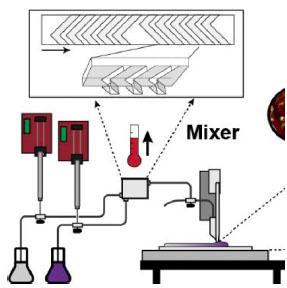Composition Gradient High-Throughput Polymer Libraries Enabled by Passive Mixing and Elevated Temperature Operability
Jul 22, 2022 — Atlanta, GA

Partial mixer diagram
A team under Martha Grover, Elsa Reichmanis, and Carson Meredith recently published a paper in Chemistry of Materials titled "Composition Gradient High-Throughput Polymer Libraries Enabled by Passive Mixing and Elevated Temperature Operability." Grad student Aaron Liu (pictured) and Ezgi Dogan-Guner (Ph.D. 2021) are co-first authors, while RahulVenkatesh, Miguel Gonzalez, and Mike McBride (Ph.D. 2019) are also listed as co-authors.
ABSTRACT: The development of high-throughput experimentation (HTE) methods to efficiently screen multiparameter spaces is key to accelerating the discovery of high-performance multicomponent materials (e.g., polymer blends, colloids, etc.) for sensors, separations, energy, coatings, and other thin-film applications relevant to society. Although the generation and characterization of gradient thin-film library samples is a common approach to enable materials HTE, the ability to study many systems is impeded by the need to overcome unfavorable solubilities and viscosities among other processing challenges under ambient conditions. In this protocol, a solution coating system capable of operating temperatures over 110 degrees C is designed and demonstrated for the deposition of composition gradient polymer libraries. The system is equipped with a custom, solvent-resistant passive mixer module suitable for high-temperature mixing of polymer solutions at ambient pressure. Residence time distribution modeling was employed to predict the coating conditions necessary to generate composition gradient films using a poly(3-hexylthiophene) and poly(styrene) model system. Poly(propylene) and poly(styrene) blends were selected as a first demonstration of high-temperature gradient film coating: the blend represents a polymer system where gradient films are traditionally difficult to generate via existing coating approaches due to solubility constraints under ambient conditions. The methodology developed here is expected to widen the range of solution processed materials that can be explored via high-throughput laboratory sampling and provides an avenue for efficiently screening multiparameter materials spaces and/or populating the large data sets required to enable data-driven materials science.
The full paper can be found in July 14, 2022, Chemistry of Materials.




